Die Inhalte dieser Seite sind leider nicht auf Deutsch verfügbar.
Seitenpfad:
- Startseite
- ...
- INTERCOAST
- Latest News
- Archiv
- News 2012
- GOST Field Campaign in Tauranga, New Zealand, February and March, 2012
INTERCOAST
GOST Field Campaign in Tauranga, New Zealand, February and March, 2012
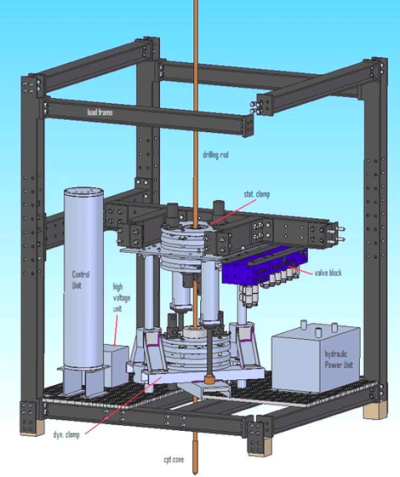
Geotechnical offshore seabed tool (GOST) section.
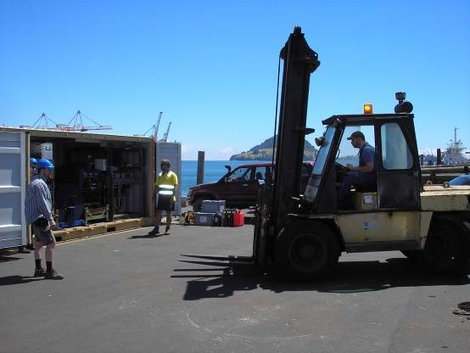
Unloading the container at Port of Tauranga, New Zealand.
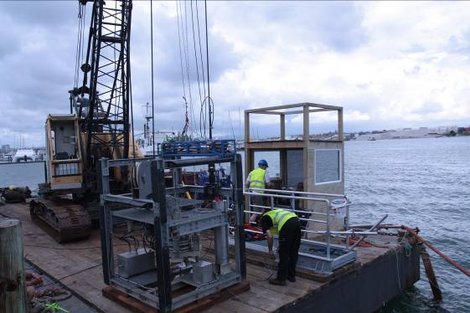
Barge before departing from the Harbour to begin the field campaign.
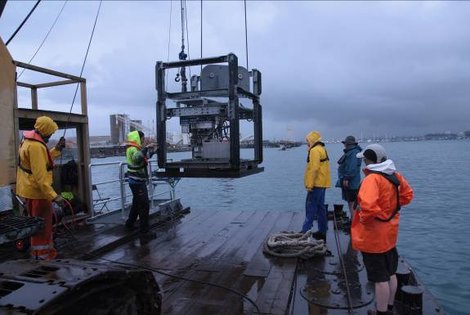
GOST ready to be lowered to the seafloor.

Omokoroa landslide site.
The recent interest in the dredging of Tauranga Harbour to widen and deepen the shipping channel to accommodate larger vessels up to 7000 TEUs (Twenty feet Equivalent Units) has provided the impetus to perform sediment stratigraphy and characterization of the area. Following a large storm during May 2005, a number of landslides occurred across the Tauranga basin region specifically in the suburb of Otumoetai. Sensitive layers which are associated with volcanic ash materials, which have subsequently weathered to soil and have high clay content, were responsible for the slope failure.
Layers of sensitive soils can remain stable for thousands of years, but once triggered, the strength of soil would no longer be sufficient enough to withstand the static stresses that act on the soil before the disturbance. Those sensitive layers are predicted to be spread over the Tauranga Harbour, especially along the dredged channel. Identification of the sensitive layers before dredging was one of the most important issues of the project in order to predict any instability prior to dredging and to make the best use of dredged materials. University of Bremen Center for Marine and Environmental Science (MARUM) proposed INTERCOAST to use the state of art in situ tool (GOST) with an exceptionally high resolution piezocone, to meet the required objectives of the study in Tauranga. The geotechnical offshore seabed tool (GOST) is a highly developed in situ tool which can perform on/offshore tests with 4000 m rating, continuous profiles, and up to 8 tons of pushing capacity.
Layers of sensitive soils can remain stable for thousands of years, but once triggered, the strength of soil would no longer be sufficient enough to withstand the static stresses that act on the soil before the disturbance. Those sensitive layers are predicted to be spread over the Tauranga Harbour, especially along the dredged channel. Identification of the sensitive layers before dredging was one of the most important issues of the project in order to predict any instability prior to dredging and to make the best use of dredged materials. University of Bremen Center for Marine and Environmental Science (MARUM) proposed INTERCOAST to use the state of art in situ tool (GOST) with an exceptionally high resolution piezocone, to meet the required objectives of the study in Tauranga. The geotechnical offshore seabed tool (GOST) is a highly developed in situ tool which can perform on/offshore tests with 4000 m rating, continuous profiles, and up to 8 tons of pushing capacity.
On July 2011, during the meeting with Prof. Dr. Katrin Huhn it was confirmed that Prof. Dr. Tobias Mörz as project leader, along with 2 professional engineers: Mr. Wolfgang Shunn and Mr. Stephan Stroble as the GOST operators, would accompany the PhD student during the project. On December 2011, GOST, along with other required tools, were shipped by container from Hamburg Harbour in Germany to Tauranga Harbour in New Zealand. The INTERCOAST program member and University of Bremen doctoral student Ehsan Jorat arrived in New Zealand on 1st of February 2012 to help University of Waikato advisors, Dr. Vicki Moon and Dr. Willem de Lange, in releasing the container from Tauranga Harbour Customs and to collect the required literature from the local authorities prior to the arrival of the 3 other members of GOST team. With the arrival of other team members in New Zealand on February 14th, the project was started by unloading the container.
It took a few days for all the necessary machinery to be loaded on the barge that was provided by the Port of Tauranga Administration Office. On February 21st the offshore measurements were started officially in predetermined locations. After 2 weeks of hard offshore works, the spectacular CPT profiles were achieved along the Tauranga Harbour. The GOST team even managed to deploy the CPT in 4 additional locations that the administration office was interested in as a contribution to the Port of Tauranga.
Offshore measurements were completed on March 5th absolutely successfully. Following the suggestions of University of Bremen and University of Waikato supervisors, a few onshore CPT tests were undertaken within the areas where the major landslides occurred, due to the sensitive soils, to allow the team to make a comparison between offshore and onshore sensitive clays of same origin and age. Deployments were performed on the 2 different sites, Pyes Pa and Omokoroa, the latter location being of special concern because five houses were lost in 1979 and since last year, the slide has reactivated.
On March 7th the GOST on/offshore operation was officially completed with the total of 27 off/onshore CPT locations and more than 350 meters CPT profiles. Throughout the project, the GOST team received invaluable assistance and support from Port of Tauranga Administration Office, especially from Mr. Rowan Johnson of the Port of Tauranga Engineering Department, Prof. Dr. Chris Battershill (Chairman) of the University of Waikato Coastal Research Tauranga Field Station, and the Western Bay of Plenty District Council. The GOST team members wish to express their gratitude for their non-stop support.
On March 7th the GOST on/offshore operation was officially completed with the total of 27 off/onshore CPT locations and more than 350 meters CPT profiles. Throughout the project, the GOST team received invaluable assistance and support from Port of Tauranga Administration Office, especially from Mr. Rowan Johnson of the Port of Tauranga Engineering Department, Prof. Dr. Chris Battershill (Chairman) of the University of Waikato Coastal Research Tauranga Field Station, and the Western Bay of Plenty District Council. The GOST team members wish to express their gratitude for their non-stop support.
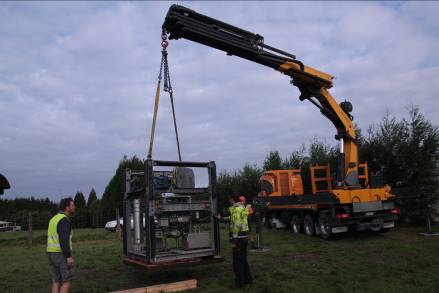
Setting GOST at the Pyes Pa landslide location.


